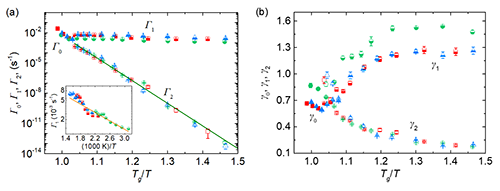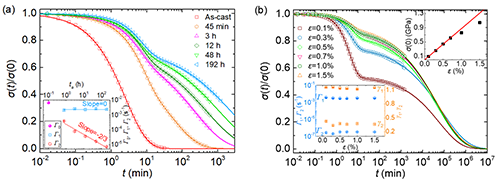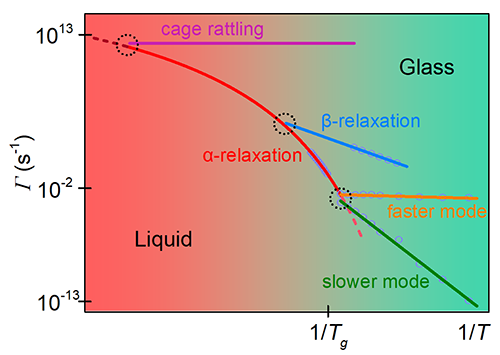Multiple channels of relaxation in glasses
Date:05-06-2017 Print
Like long geological evolution in nature, flow occurs in glasses in an extremely slow way due to the incredibly long relaxation time. Recently, Luo Peng et al. in Prof. WANG Weihua’s group from Institute of Physics, Chinese Academy of Sciences investigated the relaxation dynamics of various MGs by following the stress decay under constant strain and temperature on a dynamic mechanical analyzer (DMA). The temperatures investigated rang from the glass transition temperature, Tg, down to the deep glass and the time window spans more than five decades. They find the surprising emerging of two distinct relaxation processes as the temperature decreases. The faster process exhibits compressed exponential decay (exponent>1) and negligible temperature dependence. While the slower process shows normal stretched exponential decay (exponent<1) and an activation energy of 52kBTg corresponding to the structural α relaxation, the faster one exhibits anomalous compressed exponential decay (exponent>1) and negligible temperature dependence and differs in both time scales and activation energy from the known β relaxation, implying the occurrence of a new process proper of the glassy state that shares many similarities with the microscopic anomalous dynamics of MGs. These results suggest the existence of additional active processes in the glassy state, which are not taken into account in previous experimental and theoretical works. Their work shows that during this sluggish process, the material relaxes external stresses through two main channels resulting in a novel fast microscopic reorganization accompanying a slow heterogeneous relaxation of the whole amorphous matrix. The knowledge of how atoms (or molecules) move is crucial for understanding the state of a material, and the existence of a decoupling of relaxation modes on cooling supercooled liquids has for instance dramatically improved our knowledge on the ongoing processes responsible for the vitrification and deformation. Differently from those works, here they probe the mechanical response in the deep glassy state. Their findings of a two-step response function under stress unveil a complex dynamical pattern even at macroscopic scales and suggest the existence of a far richer-than-expected scenario in glasses with the potential occurrence of unexplored phenomena likely hidden by their long time nature.
This study entitled “Relaxation Decoupling in Metallic Glasses at Low Temperatures” was published on Physical Review Letters and selected for a Viewpoint in Physics https://journals.aps.org/prl/abstract/10.1103/PhysRevLett.118.225901
https://physics.aps.org/articles/v10/58
This work was supported by the NSF of China (51571209 and 51461165101), the MOST 973 Program (2015CB856800), and the Key Research Program of Frontier Sciences, CAS (QYZDY-SSW-JSC017).
 |
| FIG. 1. Stress relaxation profiles of three metallic glass systems, the applied tensile strain is 0.3%, solid lines are theoretical fits to the data. The obtained fitting parameters are plotted in Fig. 2. (Image by Institute of Physics) |
 |
| FIG. 2. The fitted relaxation rate (a) and exponent (b) as a function ofTg/T. (Image by Institute of Physics) |
 |
| FIG. 3. Stress relaxation profiles for samples of different ages (a) and at different strains (b). (Image by Institute of Physics) |
 |
| FIG. 4. Schematic Arrhenius diagram concerning dynamical behaviors of MG and its high temperature precursors. (Image by Institute of Physics) |
Contact:
Institute of Physics
WANG Weihua
Email: whw@iphy.ac.cn
Key word:
Glass; flow; structural relaxation; dynamic decoupling
Abstract:
Measurements of the stress response in strained metallic glasses over a wide range of temperatures and at waiting times that varied from minutes to over a week revealed a two-step relaxation process, providing the first evidence for the relaxation decoupling and the existence a new dynamic mode in the slow flow of metallic glasses.

